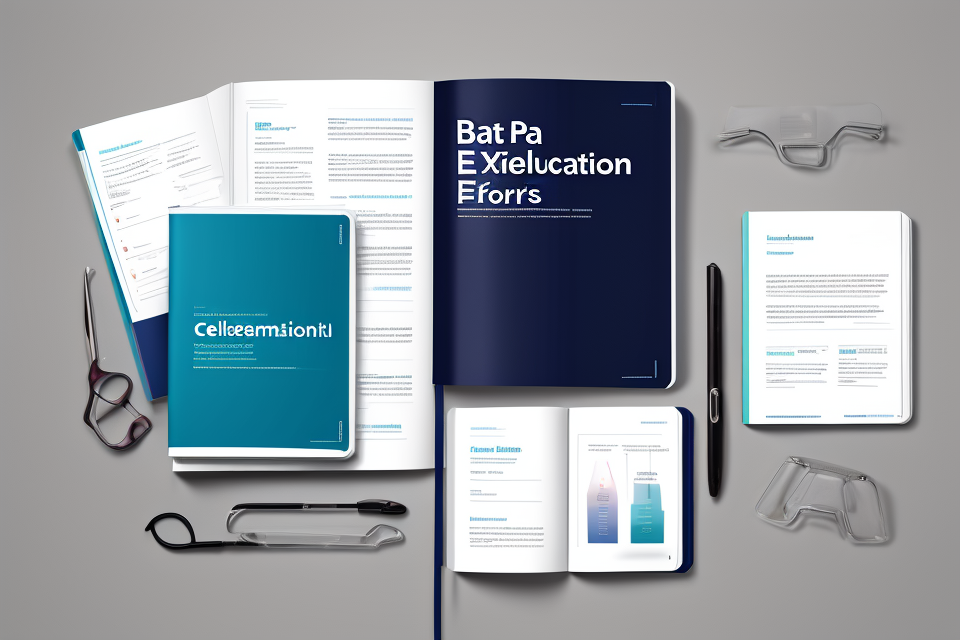
Data collection is the backbone of any research study. It is the process of gathering and measuring information on variables of interest. A successful data collection process depends on the choice of appropriate data collection instruments. In this comprehensive guide, we will explore the four essential data collection instruments used in research: surveys, interviews, observations, and experiments. Each instrument has its own strengths and weaknesses, and the choice of instrument depends on the research question, the population, and the resources available. By mastering these four data collection instruments, researchers can collect accurate and reliable data to support their research findings. So, let’s dive in and explore the world of data collection!
Understanding Data Collection Instruments
The Importance of Data Collection Instruments
- Accurate and reliable data is essential for any research study to be successful.
- Data collection instruments play a crucial role in ensuring that the data collected is accurate and reliable.
- These instruments help in collecting data in a standardized and systematic manner, which helps in reducing errors and biases.
- Data collection instruments also help in ensuring that the data collected is relevant and meaningful to the research question being asked.
- In addition, these instruments help in streamlining the data collection process, which saves time and resources.
- The choice of data collection instrument should be based on the research question, the target population, and the resources available.
- It is important to ensure that the data collection instrument is valid and reliable before using it in a research study.
- Validity refers to the extent to which the data collection instrument measures what it is supposed to measure.
- Reliability refers to the consistency and stability of the data collected using the instrument.
- A well-designed data collection instrument can help in obtaining accurate and reliable data, which is essential for making informed decisions.
The Four Essential Data Collection Instruments
When it comes to collecting data, there are a variety of tools and techniques available to researchers. However, four instruments stand out as the most commonly used and essential for any data collection process: surveys, interviews, observations, and focus groups. Each of these instruments has its own unique purpose and benefits, making them valuable tools for any researcher looking to gather information from a wide range of sources.
- Surveys are a popular method of collecting data because they allow researchers to quickly gather information from a large number of people. Surveys can be administered online, over the phone, or in person, and can be used to collect both quantitative and qualitative data. The benefits of surveys include their ability to collect a large amount of data from a diverse group of people, their flexibility in terms of format and administration, and their ability to be analyzed statistically.
- Interviews are another common data collection instrument. Interviews can be conducted in person, over the phone, or online, and can be structured or unstructured. They allow researchers to gather detailed and in-depth information from a single person or a small group of people. The benefits of interviews include their ability to gather rich, detailed data, their ability to build rapport and trust between the interviewer and interviewee, and their flexibility in terms of format and administration.
- Observations involve watching and recording behavior or interactions in a natural setting. Observations can be used to gather information about a wide range of topics, including social interactions, workplace dynamics, and consumer behavior. The benefits of observations include their ability to provide a detailed and accurate picture of behavior in a natural setting, their ability to capture information that might be difficult to obtain through other means, and their ability to be used in conjunction with other data collection instruments.
- Focus groups involve gathering a small group of people together to discuss a particular topic or issue. Focus groups can be used to gather information about consumer opinions, attitudes, and behaviors, as well as to test new products or services. The benefits of focus groups include their ability to provide rich and detailed qualitative data, their ability to build rapport and trust between the facilitator and participants, and their ability to be used in conjunction with other data collection instruments.
In conclusion, surveys, interviews, observations, and focus groups are the four essential data collection instruments that researchers can use to gather information from a wide range of sources. Each instrument has its own unique purpose and benefits, making them valuable tools for any researcher looking to collect data in a systematic and effective way.
Survey
Surveys, interviews, observations, and focus groups are the four essential data collection instruments that researchers can use to gather information from a wide range of sources. Each instrument has its own unique purpose and benefits, making them valuable tools for any researcher looking to collect data in a systematic and effective way.
What is a Survey?
A survey is a research method used to collect data from a sample of individuals or entities. It is a widely used tool in data collection because it can provide a wealth of information on a variety of topics. Surveys can be conducted in person, over the phone, or online, and can be self-administered or interviewer-administered.
There are several different types of surveys, including:
- Self-administered surveys: These are surveys that are completed by the respondent without the presence of an interviewer. They can be completed in person, over the phone, or online.
- Interviewer-administered surveys: These are surveys that are completed with the assistance of an interviewer. The interviewer asks the questions and records the responses.
- Online surveys: These are surveys that are completed online, either through a website or email. They can be self-administered or interviewer-administered.
Surveys are useful for collecting data on a wide range of topics, including customer satisfaction, employee engagement, and market research. They can be used to gather both quantitative and qualitative data, and can be designed to be either closed-ended or open-ended. Closed-ended surveys include questions with specific answer choices, while open-ended surveys allow respondents to provide their own answers.
How to Design an Effective Survey
Designing an effective survey is a critical component of the data collection process. An effective survey can yield accurate and reliable data, which can be used to make informed decisions. However, designing an effective survey is not a simple task. There are several factors that need to be considered when designing a survey. In this section, we will discuss some tips for designing an effective survey.
Tips for Designing an Effective Survey
- Define the Objectives: The first step in designing an effective survey is to define the objectives of the survey. The objectives should be specific, measurable, achievable, relevant, and time-bound. Defining the objectives will help you to design questions that are relevant to the research objectives.
- Keep it Simple: A survey should be easy to understand and should not be too long. Complex questions can lead to confusion and frustration, which can affect the response rate. Keep the questions simple and concise, and avoid using technical jargon.
- Use Clear and Concis
Advantages and Disadvantages of Surveys
Advantages
- Large sample size: Surveys can be administered to a large number of respondents, allowing for a representative sample size that accurately reflects the population being studied.
- Cost-effective: Surveys are a cost-effective method of data collection, as they can be administered online or through paper questionnaires, reducing the need for expensive equipment or specialized personnel.
- Anonymous responses: Surveys can provide anonymous responses, allowing respondents to feel more comfortable sharing sensitive information.
Disadvantages
- Response bias: Respondents may provide biased or inaccurate responses due to social desirability bias, acquiescence bias, or other factors.
- Low response rate: Low response rates can affect the validity and reliability of survey results, especially if the sample is not representative of the population being studied.
- Time-consuming: Surveys can be time-consuming to administer and analyze, especially if they are lengthy or complex.
Interviews
What is an Interview?
An interview is a qualitative research method that involves a face-to-face or telephonic conversation between the researcher and the respondent. The primary purpose of an interview is to gather detailed and in-depth information about a particular topic or issue from the respondent’s perspective. Interviews can be structured, semi-structured, or unstructured, depending on the researcher’s objectives and the nature of the topic being investigated.
- Definition of an interview and its purpose in data collection
An interview is a conversational exchange between the researcher and the respondent, where the researcher asks questions to elicit information from the respondent. The purpose of an interview is to collect rich and detailed data that can provide insights into the respondent’s experiences, attitudes, beliefs, and behaviors. Interviews are particularly useful when the researcher needs to explore complex topics or issues that require in-depth understanding.
- Explanation of the different types of interviews
There are three types of interviews: structured, semi-structured, and unstructured.
- Structured interviews: In a structured interview, the researcher asks a predetermined set of questions in a specific order. The questions are usually closed-ended, and the responses are limited to a set of predefined options. Structured interviews are useful when the researcher needs to collect quantitative data or when the topic is relatively straightforward.
- Semi-structured interviews: In a semi-structured interview, the researcher has a general outline of questions but allows the respondent to provide more open-ended responses. The questions are not strictly predetermined, and the researcher may follow up with additional questions based on the respondent’s answers. Semi-structured interviews are useful when the researcher needs to explore complex topics or issues that require more in-depth understanding.
- Unstructured interviews: In an unstructured interview, the researcher asks open-ended questions and allows the respondent to provide answers without any constraints. The questions are not predetermined, and the researcher may follow up with additional questions based on the respondent’s answers. Unstructured interviews are useful when the researcher needs to explore new or unfamiliar topics or when the researcher wants to gain a deeper understanding of the respondent’s experiences or perspectives.
How to Conduct an Effective Interview
An effective interview is a crucial aspect of data collection, and it is important to know how to conduct one to ensure accurate and reliable data. Here are some tips for conducting an effective interview:
Preparation
- Define the purpose of the interview: Before conducting the interview, it is important to define the purpose of the interview. This will help in developing the questions that will be asked during the interview.
- Develop a plan: A plan should be developed to ensure that the interview is conducted smoothly. This includes developing a schedule, identifying the location, and ensuring that all necessary equipment is available.
- Choose the right interviewee: It is important to choose the right interviewee to ensure that the data collected is accurate and reliable. The interviewee should be knowledgeable about the topic being discussed and willing to participate in the interview.
Execution
- Establish rapport: It is important to establish rapport with the interviewee to ensure that they feel comfortable and willing to share their thoughts and opinions. This can be done by using open-ended questions, actively listening to the interviewee, and showing empathy.
- Ask open-ended questions: Open-ended questions encourage the interviewee to provide detailed responses and allow for more accurate and reliable data collection. Avoid leading questions, which can influence the interviewee’s response.
- Take notes: It is important to take notes during the interview to ensure that the information collected is accurate and can be used for analysis.
Avoiding Pitfalls
- Avoid bias: It is important to avoid bias during the interview process to ensure that the data collected is accurate and reliable. This can be done by using open-ended questions, avoiding leading questions, and avoiding personal opinions or biases.
- Avoid interruptions: Interruptions can disrupt the flow of the interview and lead to inaccurate or incomplete data. It is important to create a comfortable environment for the interviewee and avoid distractions or interruptions.
- Avoid irrelevant questions: It is important to avoid irrelevant questions during the interview process to ensure that the data collected is relevant and useful for analysis. This can be done by focusing on the purpose of the interview and the goals of the data collection process.
By following these tips, you can conduct an effective interview and ensure that the data collected is accurate and reliable.
Advantages and Disadvantages of Interviews
Advantages: In-Depth Insights and Personalized Interactions
- Interviews offer the advantage of gaining in-depth insights into a particular subject matter through direct communication with the subject matter expert or participant.
- Personalized interactions allow for a more tailored approach, where questions can be adjusted on the spot to address specific concerns or issues.
Disadvantages: Time-Consuming, Potential for Interviewer Bias, and High Cost
- One disadvantage of interviews is that they can be time-consuming, as they often require significant preparation and follow-up time.
- Interviews are also susceptible to interviewer bias, as the line of questioning and interpretation of responses are heavily influenced by the interviewer’s own perspective and experiences.
- Finally, interviews can be costly, as they often require travel or other resources to accommodate the interviewee, particularly if they are located in a different geographic location.
Observations
What is Observation?
Definition of Observation and its Purpose in Data Collection
Observation is a data collection method that involves the systematic and structured observation of behavior or phenomena. The purpose of observation in data collection is to gather accurate and reliable information about a particular topic or phenomenon. Observation can be used in a variety of settings, including naturalistic, laboratory, and field settings.
Explanation of the Different Types of Observations
There are several types of observations that can be used in data collection, including:
- Naturalistic Observation: This type of observation involves observing behavior in a natural setting, without any intervention or manipulation. This method is often used in fields such as psychology and anthropology to study behavior in natural settings.
- Participant Observation: This type of observation involves the researcher becoming a participant in the setting being observed. This method is often used in fields such as sociology and cultural studies to gain an in-depth understanding of a particular culture or group.
- Controlled Observation: This type of observation involves the researcher manipulating one or more variables in order to observe the effects on other variables. This method is often used in fields such as psychology and education to study cause-and-effect relationships.
- Case Study Observation: This type of observation involves in-depth observation of a single case or a small number of cases. This method is often used in fields such as social work and education to gain a detailed understanding of a particular individual or group.
How to Conduct an Effective Observation
When it comes to data collection, observations are a valuable tool that can provide insight into human behavior and interactions. However, conducting an effective observation requires careful planning and execution to ensure that the data collected is accurate and reliable. Here are some tips for conducting an effective observation:
- Choose the right observation method: There are several observation methods to choose from, including direct observation, participant observation, and content analysis. Each method has its own strengths and weaknesses, so it’s important to choose the one that best suits your research goals and objectives.
- Plan your observation: Before you begin your observation, it’s important to plan out your approach. This includes identifying the research question or hypothesis you want to test, determining the setting and population you will observe, and deciding on the duration and frequency of the observation.
- Prepare for the observation: Preparation is key to minimizing observer bias and ensuring that your observation is as accurate as possible. This includes familiarizing yourself with the setting and population you will observe, as well as any potential challenges or distractions that may arise.
- Record your observations: It’s important to record your observations in a systematic and consistent manner. This can include taking notes, using a tape recorder, or videotaping the observation. Be sure to include as much detail as possible, including nonverbal cues and contextual information.
- Limit your observations: While it’s important to collect as much data as possible, it’s also important to limit your observations to avoid observer fatigue and bias. This can include setting a specific time limit for the observation or breaking it up into smaller chunks.
- Analyze your data: Once you have collected your data, it’s important to analyze it in a systematic and objective manner. This can include coding your observations, identifying patterns and themes, and comparing your findings to previous research.
By following these tips, you can conduct an effective observation that will yield accurate and reliable data. Remember to plan your observation carefully, prepare thoroughly, and record your observations systematically to ensure that your data is as accurate and unbiased as possible.
Advantages and Disadvantages of Observations
Advantages of Observations
- Direct and accurate data: Observations provide direct and accurate data that is collected through the senses, reducing the potential for errors or biases.
- Non-intrusive: Observations are a non-intrusive method of data collection, as they involve simply observing behaviors or phenomena without intervening or manipulating the environment.
Disadvantages of Observations
- Time-consuming: Observations can be a time-consuming process, particularly when a large amount of data needs to be collected or when observations need to be conducted over an extended period.
- Potential for observer bias: The data collected through observations is influenced by the observer’s own biases, beliefs, and expectations, which can impact the accuracy and reliability of the data.
- High cost: Observations can be expensive, particularly when specialized equipment or technology is required to collect the data. Additionally, the cost of time and resources needed to conduct observations can be significant.
Focus Groups
What is a Focus Group?
A focus group is a qualitative research method that involves a group of individuals who are carefully selected to participate in a discussion on a particular topic. The primary purpose of a focus group is to gather insights and opinions from a targeted audience, with the aim of gaining a deeper understanding of their thoughts, behaviors, and preferences.
There are two main types of focus groups: moderated and unmoderated. In a moderated focus group, a trained moderator leads the discussion and guides the participants through a series of questions. The moderator may also prompt participants to share their thoughts and opinions, and encourage group interaction. In an unmoderated focus group, the participants are left to discuss the topic among themselves without any guidance or intervention from a moderator.
Both moderated and unmoderated focus groups have their own advantages and disadvantages, and the choice of which type to use will depend on the research objectives and the target audience.
How to Conduct an Effective Focus Group
Tips for Conducting a Focus Group
- Select a suitable location for the focus group, preferably a private and quiet room that can accommodate the number of participants.
- Ensure that the participants are comfortable and relaxed by providing refreshments and seating arrangements that promote engagement.
- Prepare a detailed agenda for the focus group, outlining the topics to be discussed and the questions to be asked.
- Encourage active participation from all members of the group by using open-ended questions and facilitating discussions that are non-confrontational and non-judgmental.
- Record the session, either through audio or video recording, to capture important details and to refer back to the discussion later.
Explanation of How to Prepare for a Focus Group
- Identify the research objective and the target audience for the focus group.
- Develop a clear and concise research question that will guide the discussion.
- Recruit participants who fit the target audience and are willing to participate in the focus group.
- Prepare a detailed discussion guide that includes an introduction, a brief overview of the research question, and a list of open-ended questions to prompt discussion.
- Test the equipment and the recording process to ensure that the session runs smoothly.
Explanation of How to Facilitate Discussion and Avoid Common Pitfalls
- Introduce the research question and the purpose of the focus group to the participants.
- Avoid leading questions that may bias the responses of the participants.
- Take detailed notes during the discussion to capture important details and to refer back to the discussion later.
- Summarize the key points discussed during the focus group and thank the participants for their time and input.
Advantages and Disadvantages of Focus Groups
Focus groups are a qualitative research method that involves gathering a small group of individuals to discuss a particular topic or product. This method can provide valuable insights into consumer attitudes, opinions, and preferences. However, like any research method, focus groups have their advantages and disadvantages.
- In-depth insights: Focus groups provide an opportunity for researchers to delve deeper into a topic and gain a better understanding of consumer behavior and motivations. The group discussion format allows for follow-up questions and probing, which can help researchers uncover hidden insights.
-
Group dynamics: Focus groups allow researchers to observe how participants interact with each other and how their opinions may be influenced by the group dynamics. This can provide valuable information on how consumers make decisions in social settings.
-
Potential for groupthink: Focus groups can sometimes result in groupthink, where participants conform to the dominant viewpoint, suppressing their individual opinions. This can lead to biased results and limit the range of opinions expressed.
- High cost: Conducting focus groups can be expensive, as it requires a dedicated facility, trained moderators, and incentives for participants. Additionally, the cost of transcribing and analyzing the data can be significant.
- Time-consuming: Focus groups can be time-consuming, as they require a significant amount of time to plan, conduct, and analyze the data. This can make it difficult to conduct multiple focus groups or recruit a large sample size.
Overall, while focus groups can provide valuable insights, it is important to carefully consider the advantages and disadvantages when deciding if this method is appropriate for a particular research project.
FAQs
1. What are the four data collection instruments?
The four data collection instruments are: (1) Surveys, (2) Interviews, (3) Observations, and (4) Document analysis. These instruments are commonly used in research and data collection to gather information from various sources.
2. What is a survey?
A survey is a data collection instrument that involves asking a set of questions to a predefined group of respondents. Surveys can be conducted through various modes such as online, telephone, or in-person interviews. They are commonly used to collect information from a large number of people.
3. What is an interview?
An interview is a data collection instrument that involves a face-to-face or virtual conversation between an interviewer and an interviewee. Interviews can be structured or unstructured and can be conducted with individuals or groups. They are commonly used to gather in-depth information on a specific topic.
4. What is observation?
Observation is a data collection instrument that involves systematically watching and recording behavior or phenomena in a natural setting. It can be used to gather information on human behavior, social interactions, or environmental factors. Observations can be conducted through direct observation or through the use of technology such as cameras or sensors.
5. What is document analysis?
Document analysis is a data collection instrument that involves examining and interpreting documents to gather information. Documents can include written reports, records, or any other form of written communication. Document analysis is commonly used to gather information on historical events, policies, or organizational practices.







